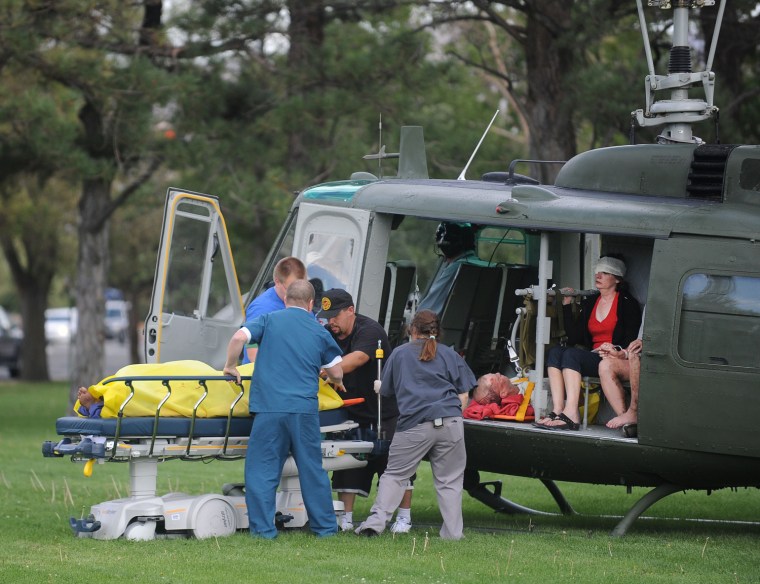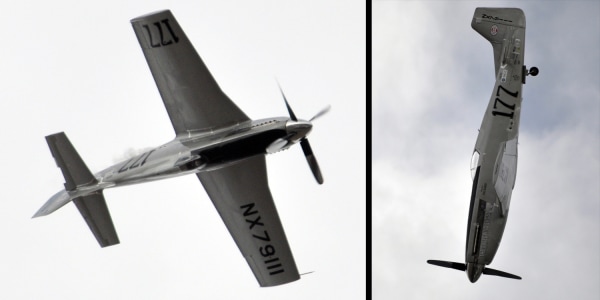The death toll rose to nine Saturday in an air race crash in Reno as investigators determined that several spectators were killed on impact as the 1940s-model plane appeared to lose a piece of its tail before slamming like a missile into a crowded tarmac.
The deaths include seven who were killed on the tarmac, including the 74-year-old pilot, and two others who died at hospitals, Reno Deputy Police Chief Dave Evans said.
Photographs showed a piece of the tail missing before the crash.
The higher death toll was announced at a briefing a day after the Friday afternoon crash. Authorities previously said that three people had perished.
An airplane component was recovered, but investigators haven't identified it or even determined if it came from the fallen P-51 Mustang aircraft, said Mark Rosekind, National Transportation Safety Board member and spokesman for investigation.
"We are going to focus on that," Rosekind said.
Federal investigators worked Saturday on the tarmac where debris had been sprayed by the violent impact of the crash. Reno police provided a GPS mapping system to offer an overview for investigators to recreate the crash scene.
By noon, the runway at the airfield had been mostly swept and was opened for takeoffs only, officials said.
On Friday, as thousands watched in horror, the P-51 Mustang suddenly pitched upward, rolled and nose-dived toward the crowded grandstand. It then slammed into the tarmac and blew to pieces in front the pilot's family and a tight-knit group of friends who attend the annual event.
"It came down directly at us. As I looked down, I saw the spinner, the wings, the canopy just coming right at us. It hit directly in front of us, probably 50 to 75 feet," Ryan Harris, of Round Mountain, Nev., told the AP. "The next thing I saw was a wall of debris going up in the air. That's what I got splashed with. In the wall of debris noticed there were pieces of flesh."
Bloodied bodies spread across the area as people tended to the victims and ambulances rushed to the scene. Video and photos of the crash were captured by several people in the stands, and the horrific images of the wreckage were transmitted around the world within minutes.
"Normally when you see an air crash, you see recognizable wreckage. There was nothing, just little bits of metal," said John Townes, a Reno pilot.
Friday's crash was the first time spectators were killed or seriously injured.
Among the dead identified by the Washoe County, Nev., medical examiner was spectator Greg Morcom, 47, of Washington state. He was pronounced dead at the scene of the crash, said TV station KOMO of Seattle.
Among other spectators Michael Wogan, 22, of Phoenix, perished at the scene and his father, Bill Wogan, lost his right eye, some fingers on his right hand, suffered over 100 fractures to his face, and remains in critical condition at a Reno hospital, according the The Arizona Republic.
The names of the other seven fatalities were not released.
As of Saturday afternoon, 40 of the 69 people injured enough to be treated at hospitals had been discharged. The conditions as those still held: eight, critical; nine, serious; 10 fair; two good.

Modifications to aircraft
The Reno pilot, Jimmy Leeward, of Ocala, Fla., was a veteran airman and movie stunt pilot who named his P-51 Mustang fighter plane "The Galloping Ghost."
The plane had a minor crash almost exactly 40 years ago in Reno after its engine failed. According to two websites that track P-51s that are still flying, it made a belly landing away from the airport. The NTSB report on the Sept. 18, 1970, incident says the engine failed during an air race and it crash-landed short of the runway.
P-51 historian Dick Phillips of Burnsville, Minn., said on Saturday that the plane had had several new engines since then as well as a new canopy and other modifications.
In a podcast uploaded to YouTube in June, Leeward said major changes were made to the plane before this year's race. He said his crew cut five feet off each wing and shortened the ailerons — the back edge of the main wings used to control balance — to 32 inches, down from about 60 inches.
The goal was to make the plane more aerodynamic so it would go faster without a bigger engine.

"I know the speed. I know it'll do the speed. The systems aren't proven yet. We think they're going to be OK," he said.
Tim O'Brien of Grass Valley, Calif., who is chairman of an air show in his hometown and photographed Friday's races, said Leeward's P-51 was racing six other planes and was in the process of moving from third place into second when it pitched violently upward, rolled and then headed straight down.
From the photos he took, O'Brien said it looked like a piece of the plane's tail called a "trim tab" had fallen off. He believes that's what caused the plane's sudden climb.
When the aircraft hit the ground, there was a "big explosion but no fire," O'Brien said.
Prior to Friday, 19 people had been killed at the National Championship Air Races since their start in 1964, organizers said, at least two in P-51s. In 1999, a Mustang disintegrated during a race, scattering debris and damaging a house. In 1994, one of the planes crashed next to a runway after engine failure sprayed the windshield with oil.
Organizers softened two of the curves pilots negotiate after crashes into nearby neighborhoods in 1998 and the one in 1999. In 2007 and 2008, four pilots were killed at the races, prompting local school officials to consider barring student field trips to the event.
'He saved hundreds'
Some onlookers said Leeward had done what he could to avoid people on the ground.
"If he wouldn't have pulled up, he would have taken out the entire bleacher section," said Tim Linville, 48, of Reno, who watched the race with his two daughters.
"The way I see it, if he did do something about this, he saved hundreds if not thousands of lives because he was able to veer that plane back toward the tarmac," said Johnny Norman, who was at the show.
Leeward's family expressed their sorrow in a message posted on Facebook .
"Dear friends, we are deeply saddened by the tragedy at the air race today. Please join us in praying at this time for all the families affected," they said.
Slideshow 12 photos
Reno air race crash
'Unbelievable gore'Witness Maureen Higgins of Alabama said the pilot was on his third lap when he lost control of the plane. She told the Gazette-Journal she was sitting about 30 yards away from the crash and the man in front of her was struck in the head by a piece of debris.
"I saw body parts and gore like you wouldn't believe it. I'm talking an arm, a leg," Higgins told the newspaper. "The alive people were missing body parts. I am not kidding you. It was gore. Unbelievable gore."
Video apparently taken from the stands and posted on YouTube after several other planes raced by in the air.
Spectators could be heard gasping: "Oh my God." A photograph captured the doomed plane, nose down just before impact.
Local TV stations aired videotape of the scene that showed numerous people being treated at the scene or being carried on stretchers to ambulances.
Debris from the crash was strewn through a seating area in front of the grandstands.
“It’s just like a massacre. It’s like a bomb went off,” said Dr. Gerald Lent of Reno, who witnessed the crash, told the Gazette-Journal. “There are people lying all over the runway.”
The NTSB issued a statement on YouTube, expressing its condolences to the victims and their relatives.
The retired astronaut husband of U.S. Rep. Gabrielle Giffords was supposed to fly at the Reno air races, according to the Arizona Daily Star.
Giffords' spokesman Mark Kimble said Mark Kelly was in Reno for the event as a guest of the Breitling watch company. He was supposed to perform aerobatics. Kelly was not at the event when the crash occurred.
The Arizona congresswoman was in Houston recovering from an assassination attempt Jan. 8.
'Most historic'
The National Championship Air Races draws thousands of people to Reno every September to watch various military and civilian planes race.
The FAA and air race organizers spend months preparing for air races as they develop a plan involving pilot qualification, training and testing along with a layout for the course. The FAA inspects pilots' practice runs and briefs pilots on the route maneuvers and emergency procedures.
On the YouTube video, Leeward was optimistic about the changes made to the plane and his chances at winning.
"It's probably the most historic, most significant unlimited air racer in the history of air racing," he said of the type of racing.
"I hope I'll be able to guide it to victory at Reno this year."
